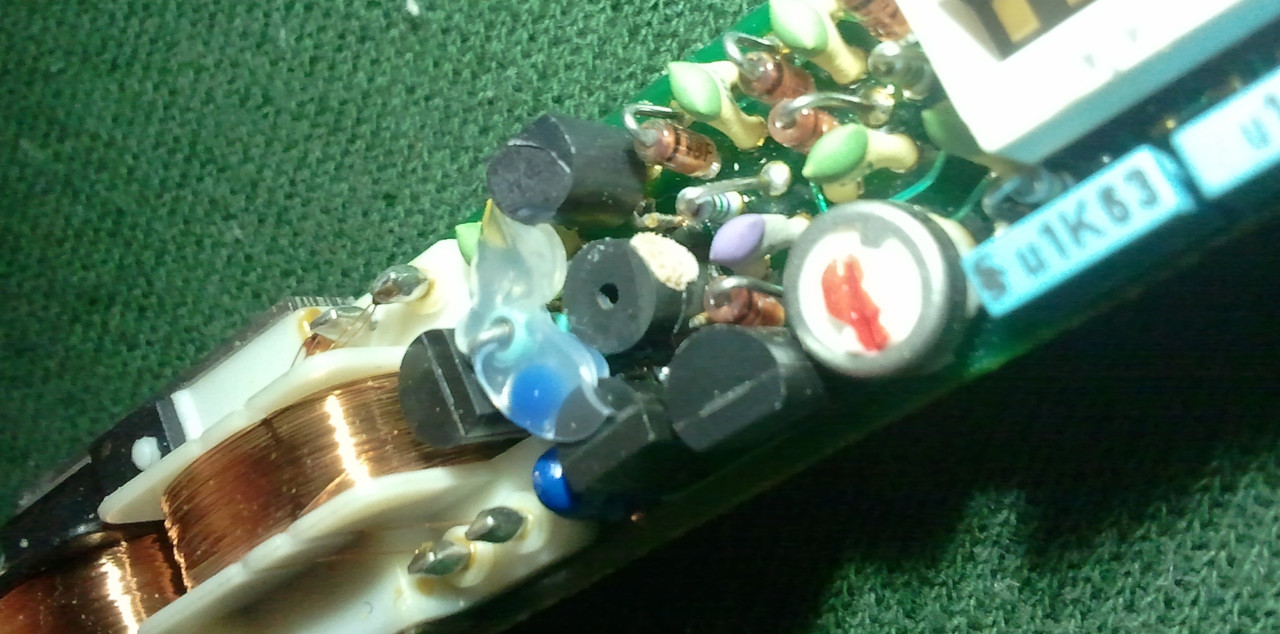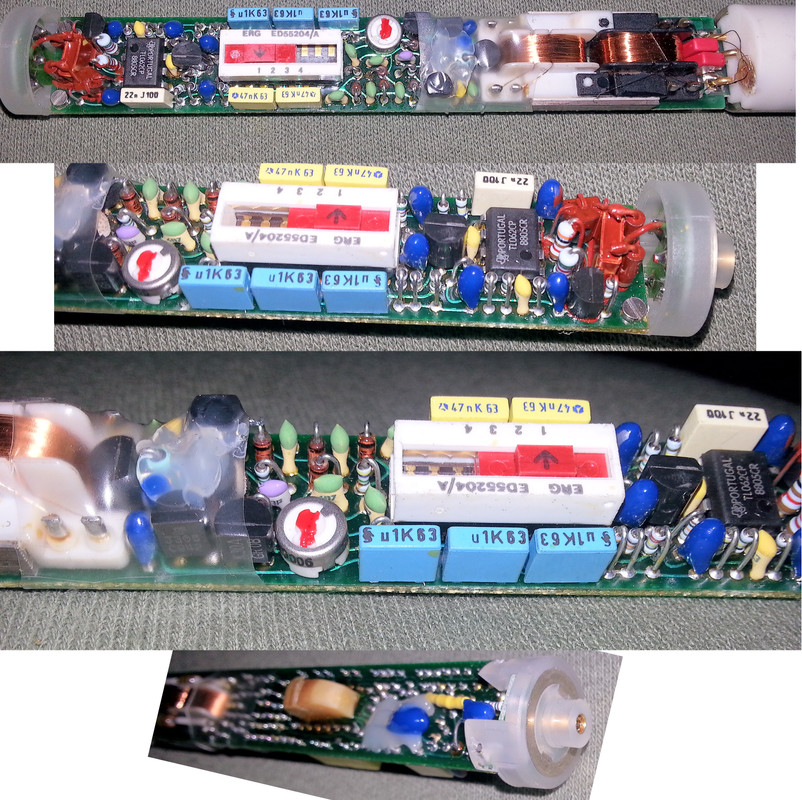hello
I have an akg 460b. the pre amp section started to have an intermittent brushy type sound..almost like an oxidised cable connection sound now and then.
I took it apart and found under a piece of plastic wrap and a blob of heat gun glue, one component which has a strange leak, white fuzzy chemical appearance, from its side.
I attach a picture below,
Does this part look damaged? Can anyone identify the part?
Thank you very much for your help.

I have an akg 460b. the pre amp section started to have an intermittent brushy type sound..almost like an oxidised cable connection sound now and then.
I took it apart and found under a piece of plastic wrap and a blob of heat gun glue, one component which has a strange leak, white fuzzy chemical appearance, from its side.
I attach a picture below,
Does this part look damaged? Can anyone identify the part?
Thank you very much for your help.

That looks like a small inductor or ferrite core.
You probably overheated it with your heat gun and some potting mkaterial oozed out.
Not sure why you overheated it in the first place.
You probably overheated it with your heat gun and some potting mkaterial oozed out.
Not sure why you overheated it in the first place.
hi.
I did not use a heat gun. I had to cut off some hot glue to see it properly and take a picture. The hot glue was there already from the factory.
I did not use a heat gun. I had to cut off some hot glue to see it properly and take a picture. The hot glue was there already from the factory.
According to the service manual, that should be autotransformer Ü62, part of a DC/DC converter. Probably nothing to do with the problem.
Rustling noises are usually caused by leaky electrolytic (/ tantalum) coupling caps, FETs or transistors, or bad solder joints. Unfortunately, there is no shortage of potential candidates in this circuit. I would probably want to have a (makeshift) signal tracer for any chance of narrowing it down to a particular stage.
Mic circuits tend to have plenty of "secret sauce" factor about them, and I must say this one does not disappoint. Not exactly sure how this input bootstrap thingamajig works.
Rustling noises are usually caused by leaky electrolytic (/ tantalum) coupling caps, FETs or transistors, or bad solder joints. Unfortunately, there is no shortage of potential candidates in this circuit. I would probably want to have a (makeshift) signal tracer for any chance of narrowing it down to a particular stage.
Mic circuits tend to have plenty of "secret sauce" factor about them, and I must say this one does not disappoint. Not exactly sure how this input bootstrap thingamajig works.
Does it look like wood / Silicone glue. There are indeed SMPS which use that kind of white glue, but in Your case they used heat gun glue on top, so it doesn't make sense the other one, unless it was repaired before.
Thank you for your responses.
I include a few pictures (joined together into one picture)
You can see the plastic I cut off with glue underneath to take the first picture.( I was hoping it was a leaking cap until I cut it away : /)
I may re-flow the xlr points with a soldering iron and see if that helps. The gold contacts on the switch look good.
I wonder if anyone could suggest the first things to replace? I have a de soldering machine. I am a novice with circuits, but am pretty good with an de/soldering iron.

I include a few pictures (joined together into one picture)
You can see the plastic I cut off with glue underneath to take the first picture.( I was hoping it was a leaking cap until I cut it away : /)
I may re-flow the xlr points with a soldering iron and see if that helps. The gold contacts on the switch look good.
I wonder if anyone could suggest the first things to replace? I have a de soldering machine. I am a novice with circuits, but am pretty good with an de/soldering iron.

I would use 'Deoxid' on those swithes 1-4 first and see what happens. Switches have a tendency to oxidize. Sometimes its a small thing with big consequences.
thank you very much.
Here is what I did for anyone else in trouble
I just happened to have some deoxit and sprayed a little (not easy to spray a little out these canisters, so easy to waste it) into the switch, immediately I slid it back and forth a fair few times. I sprayed some onto a cotton bud (cue tip) and wiped around the xlr pins and the thread on both the capsule and preamp (a fair bit of tarnish or dust came off there for some reason)
And it seems to have fixed the issue. : )
So that very expensive deoxit seems to have been worth while after all.
Thank you all for your support, as I certainly could afford a new preamp or capsule.
Here is what I did for anyone else in trouble
I just happened to have some deoxit and sprayed a little (not easy to spray a little out these canisters, so easy to waste it) into the switch, immediately I slid it back and forth a fair few times. I sprayed some onto a cotton bud (cue tip) and wiped around the xlr pins and the thread on both the capsule and preamp (a fair bit of tarnish or dust came off there for some reason)
And it seems to have fixed the issue. : )
So that very expensive deoxit seems to have been worth while after all.
Thank you all for your support, as I certainly could afford a new preamp or capsule.
^* could not afford a new mic, is what I meant to say. edit is not working.
Thank you very much : )
Thank you very much : )
Edit times out after some minutes, its only for second thoughts when posting...
Probably gradual build up of oxides and/or sulfides on the contacts until metal-metal contact is compromised. Switches usually only self-clean when regular currents flow of at least several milliamps - enough to disrupt insulating films, so low power switches are more commonly affected this way (for instance a mains light switch doesn't suffer this problem - other problems certainly, but not this).
Probably gradual build up of oxides and/or sulfides on the contacts until metal-metal contact is compromised. Switches usually only self-clean when regular currents flow of at least several milliamps - enough to disrupt insulating films, so low power switches are more commonly affected this way (for instance a mains light switch doesn't suffer this problem - other problems certainly, but not this).
Darn it. I spoke too soon
The issue is still here. It maybe after it warms up a bit. it is also intermittent. not all the time.
I have tried other condenser mics and they are fine with the exact signal chain. The phantom is at 48.2v.
Can someone please be kind enough to share the .pdf so I know what tantalums to buy and replace in this microphone?
I have a service .pdf but it is very blurry and not able to see the component names.
Thanking you kindly.
The issue is still here. It maybe after it warms up a bit. it is also intermittent. not all the time.
I have tried other condenser mics and they are fine with the exact signal chain. The phantom is at 48.2v.
Can someone please be kind enough to share the .pdf so I know what tantalums to buy and replace in this microphone?
I have a service .pdf but it is very blurry and not able to see the component names.
Thanking you kindly.
- Status
- Not open for further replies.
- Home
- Source & Line
- Analogue Source
- Component blown?